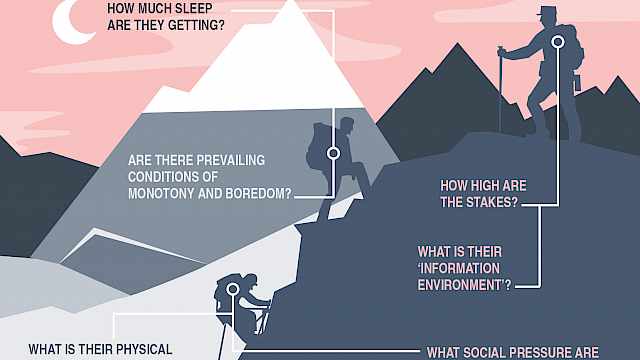Over the past 30 years, there has been a growing focus on the needs of displaced people that recognises the psychological impact of humanitarian disasters. The seismic displacement of refugees from Syria, in particular, has meant mental health and psycho-social needs have been reprioritised as equitable to those of food, security, and physical health. But assessing these needs is complex, and understanding the impact of how to go about exploring and questioning refugee experiences has significant implications for those working in this field.
One approach is Mental Health and Psycho-Social Support (MHPSS). This works on the basis that by identifying the effects of stress and finding ways to strengthen resilience, refugee communities are better protected and better able to function. For countries such as the UK looking to positively accelerate integration and maximize protection, understanding this MHPSS approach is key.
Research consistently shows that the greater the post-migration stress refugees experience, the lower the levels of psycho-social wellbeing.
With this comes not only a greater possibility of resurfacing pre-migration trauma, but it also risks a spiral of ineffective intervention.
Registering, interviewing, and assessing those whose mental and psycho-social needs are not recognised risks fundamental misattributions and misunderstandings about the nature of refugees. Practitioners in the asylum system, local authorities, or policing need to ensure their approach yields rich and accurate psycho-social accounts so that interventions around risk management, protection, and community resilience are valid and meaningful to those they look to protect.
Assessing Mental Health and Psych-Social Support (MHPSS)
One approach, put forward by the WHO and UNHCR, integrates the collection and assessment of psychological needs through a toolkit which ranges from interviews with key informants, through to household questionnaires and participatory assessments. But while this approach gets to what the psycho-social problems of displacement may be, it risks overlooking how and why these needs operate. Inferring assumptions based on standardised risk factors undermine the significance of how individuals actually experience and manage the stress they face. Further, the need for expediency can lead to psycho-social problems being over generalised with cultural and contextual factors being either neglected or diminished. In working with refugees or asylum seekers, assessments and interviews require a far richer and more nuanced approach.
The influence of social identity
Recent developments within social identity research suggest an approach that may improve practitioners’ understanding of refugee wellbeing. Research has consistently demonstrated how the social categories we use to make sense of who we are, not only shape how we experience stress but also determine the degree to which we feel we have the resources to cope with it.
Researchers have demonstrated that those identities which we feel are important and define us at a particular moment in time significantly influence how we appraise a situation as being stressful. These same identities also give us an important sense of how we may adjust or overcome these problems. For example, the social identity of ‘refugee’ may bring into sharp relief problems that only refugee communities face, while also offering solidarity through the meaningful relationships and resources they collectively provide.
Stories, stones, and social identities
In exploring this approach through my own research with Syrian refugees settling in Brazil and the UK, social identity has been central within refugee experiences. Using a narrative in-depth interview approach, I have introduced the technique of Wearmouth’s ‘Talking Stones’ in which stones are used to enable the interviewee to project elements of themselves, or their experiences, into their personal accounts as key markers.
Encouraging this form of factual storytelling is an effective way to unearth the important social and meaningful aspects of a person’s life, and it is an approach particularly well suited to represent the multiple nature of people’s identities, particularly for those in transition. Asking refugees to speak about their experiences as a narrative account, rather than rate the impact of certain pre-determined problems, allows the factual experiences and complexities they have encountered to emerge naturally.
Using stones in interviews has not only helped refugees to articulate aspects of their life that may be too difficult or painful to share, but it has allowed them to represent a range of significant actors and influencers: themselves, the interviewer, particular groups, and specific events. By doing so it represents these factors in relational ways, bringing to light subjective experiences that are easily overlooked in more generalised accounts.
In one example, a Syrian refugee mapped out his experiences through clusters of stones that represented both those groups that provide vital information and psycho-social support and those that presented a continual threat and challenge. He then drew a boundary to show where he felt the ‘frontiers’ of his life were. For example, when asked how he felt about other Arabs in his community, he quickly selected a piece of sea glass. Arabs in Brasília, he argued, were like shards of glass, ‘they hurt’ and they have no place on his side of the boundary. Using these stones, rich insights into the lives and stresses of refugees can come to the fore, often contradicting those we may erroneously hold about cultures we do not truly understand.
Accounting for the influence of the interview itself is also significant; such interviews do not stand outside refugee encounters but are a fundamental part of their lived experience. Using this technique, interviewees could also indicate where I, as the interviewer, stood in relation to their world, with whom they felt I aligned, and how, over the course of our interviews, this relationship changed.
Working with refugees in this way presents considerable ethical and methodological challenges ranging from the recognition and management of important power dynamics between interviewer and participant, through to safeguarding all those who choose to take part, and the information they share. But overall, working with refugees in this capacity requires that their psycho-social health is prioritised; it is essential to not only ensure that the interview methods and approaches are sensitive and appropriate to the context but also do not put refugee wellbeing at further risk.
To ensure engagement is participant-led and wellbeing is prioritised, interview with refugees should aim to:
- Minimise the risk to the person involved, both in terms of their security and their psychological health. Sharing sensitive and, at times, traumatic experiences can put the person at greater risk, both physically and psychologically.
- Allow the experiences of the person to be invited in such a way that they are prioritised over any pre-determined idea of risk, stress or coping. Generalisations about what certain groups find stressful or adverse can easily lead to costly, misplaced or even disabling interventions.
- Allow for the influence of the practitioner’s identity to be accounted for. Refugees are a vulnerable population who are easily exposed to and disadvantaged by power disparities.
- Foreground personal meanings, culture and context within the accounts given. Particular experiences must be contextualised so that interventions can be designed with the advantage of knowing ‘why’ and ‘how’, not just ‘what’.
- Support participant wellbeing. Practitioners should always question the impact their work has on vulnerable populations.
Read more
- John Drury. 2012. ‘Collective Resilience in Mass Emergencies and Disasters: A Social Identity Model’. In The Social Cure: Identity, Health and Well-Being, edited by Jolanda Jetten, Catherine Haslam, and S. Alexander Haslam, 195–215. Hove; New York: Psychology Press.
- Ian Gough, Allister Mcgregor, and Laura Camfield. 2007. ‘Theorising Wellbeing in International Development’. In Wellbeing in Developing Countries: From Theory to Research, edited by Ian Gough and J. Allister McGregor, 3–43. Cambridge, UK: Cambridge University Press.
- Catherine Haslam, Jolanda Jetten, Tegan Cruwys, Genevieve Dingle, and S. Alexander Haslam. 2018. The New Psychology of Health: Unlocking the Social Cure. 1 edition. New York: Routledge.
- Halit Hulusi and Louise Oland. 2010. ‘Using Narrative to Make Sense of Transitions: Supporting Newly Arrived Children and Young People’. Emotional and Behavioural Difficulties 15 (4): 341–51. Available at: https://doi.org/10.1080/13632752.2010.523247.
- Jolanda Jetten, Catherine Haslam, and S. Alexander Haslam, eds. 2011. The Social Cure: Identity, Health and Well-Being. 1 edition. Hove ; New York: Psychology Press.
- Richard Lazarus and Susan Folkman. 2000. Stress, Appraisal, and Coping. New York: Springer Publishing.
- Kenneth Miller and Andrew Rasmussen. 2010. ‘War Exposure, Daily Stressors, and Mental Health in Conflict and Post-Conflict Settings: Bridging the Divide between Trauma-Focused and Psychosocial Frameworks’. Social Science & Medicine, Conflict, violence, and health, 70 (1): 7–16. Available at: https://doi.org/10.1016/j.socscimed.2009.09.029.
- Stephen Reicher and S. Alexander Haslam. 2006. ‘Rethinking the Psychology of Tyranny: The BBC Prison Study’. The British Journal of Social Psychology 45 (Pt 1): 1–40; discussion 47-53. Available at: http://www.bbcprisonstudy.org/pdfs/bjsp(2006)tyrannny.pdf.
- Sarah Scuzzarello. 2015. ‘Narratives and Social Identity Formation among Somalis and Post-Enlargement Poles’. Political Psychology 36 (April): 181–98. Available at: https://doi.org/10.1111/pops.12071.
- Michael Ungar. 2005. ‘Introduction: “Resilience across Culture and Contexts”’. In Handbook for Working with Children and Youth: Pathways to Resilience Across Cultures and Contexts, edited by Michael Ungar. Thousand Oaks: SAGE Publications. Available at: http://www.resilienceproject.org/files/PDF/introduction_resilience_across_cultures_and_contexts.pdf.
- Janice Wearmouth. 2004. ‘“Talking Stones”: An Interview Technique for Disaffected Students’. Pastoral Care in Education 22 (2): 7–13.
Copyright Information
As part of CREST’s commitment to open access research, this text is available under a Creative Commons BY-NC-SA 4.0 licence. Please refer to our Copyright page for full details.






